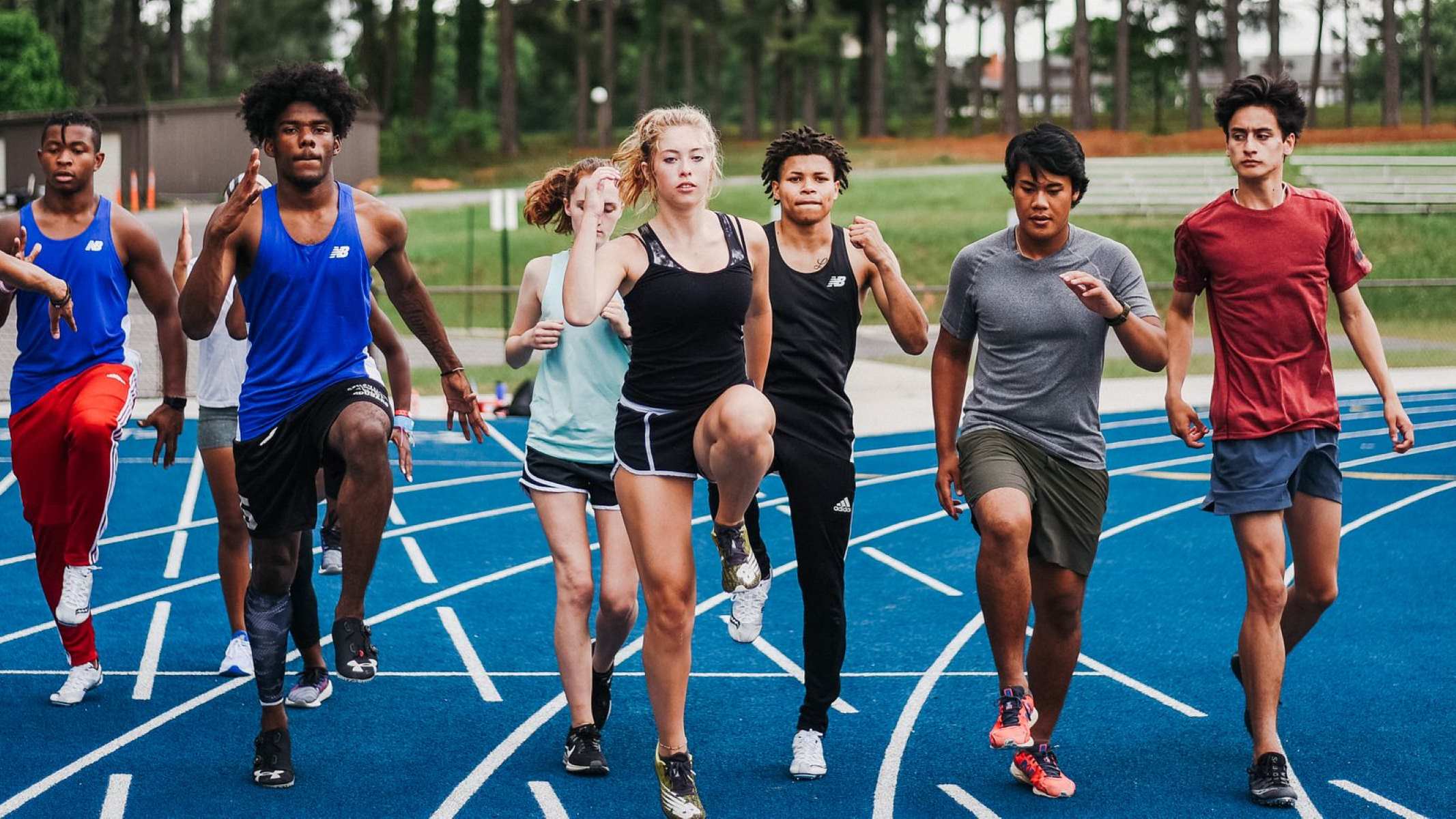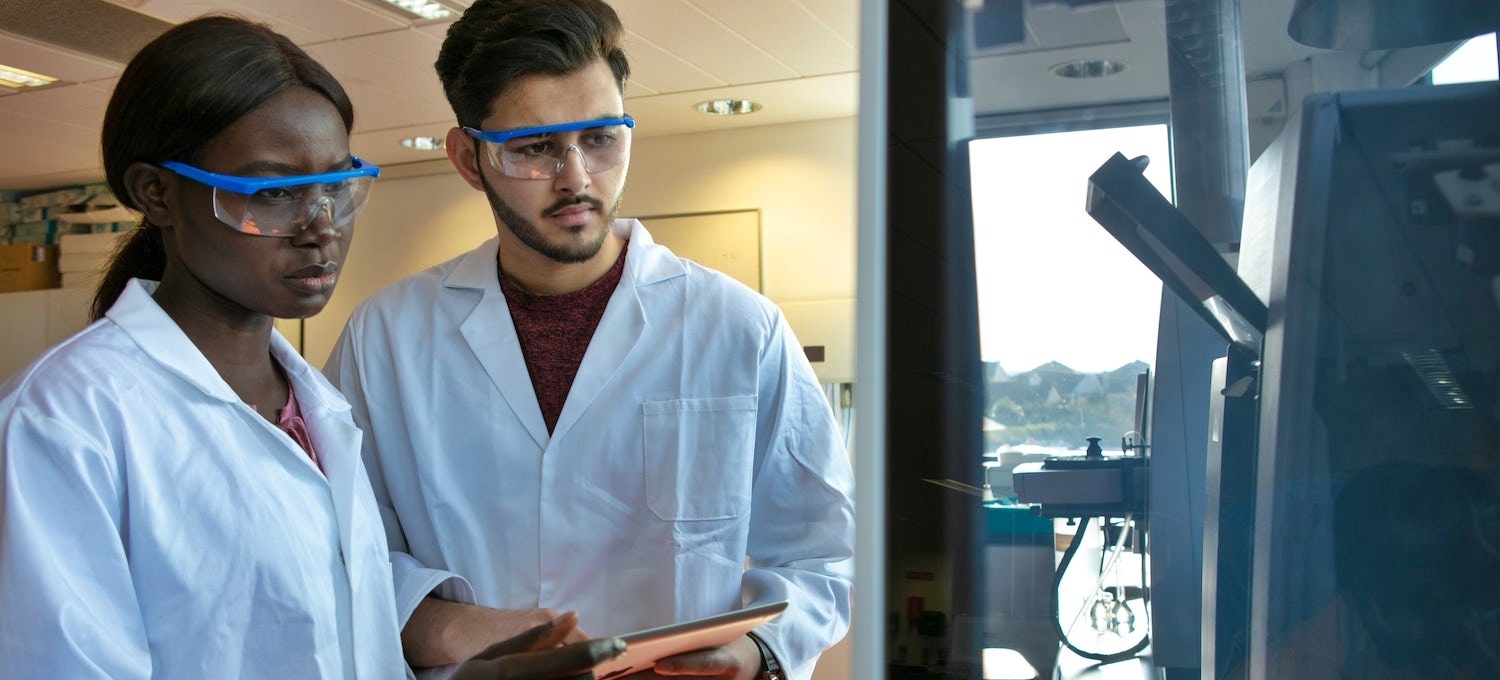Home>Misc>Featured>What Type Of Research Would Study Ways To Enhance Athletic Performance?


Featured
What Type Of Research Would Study Ways To Enhance Athletic Performance?
Modified: January 2, 2024
Discover the Featured Research That Explores Techniques to Improve Athletic Performance, Uncovering Ways to Enhance Your Sporting Abilities and Achieve Optimal Results.
Introduction
Enhancing athletic performance is a topic of great interest and importance in the world of sports. Athletes, coaches, and scientists are constantly seeking ways to improve performance and gain a competitive edge. But what type of research can provide valuable insights into the strategies and techniques that can boost athletic performance?
The study of athletic performance is a multidisciplinary field that combines aspects of physiology, psychology, biomechanics, nutrition, and more. Researchers aim to understand the factors that contribute to an athlete’s success and explore ways to optimize their abilities.
Various research methods can be employed to investigate different aspects of athletic performance. These methods range from experimental studies that manipulate variables to observational studies that observe athletes in their natural environment. Additionally, both quantitative and qualitative research approaches are used to gain a comprehensive understanding of the topic.
This article will delve into the different types of research methods used to study ways to enhance athletic performance. We will explore the various quantitative and qualitative approaches employed by researchers and highlight their advantages and limitations. By understanding the diverse methods available, we can gain insights into the extensive research conducted in this field and the potential avenues for further exploration.
It is important to note that enhancing athletic performance is not limited to professional athletes. The research conducted in this field has practical implications for individuals at all levels of sports participation, from recreational athletes looking to improve their skills to elite athletes striving for podium finishes.
Now, let’s delve into the factors that affect athletic performance and how research can shed light on strategies to enhance these aspects. By understanding the intricacies of athletic performance, we can develop evidence-based methods to help athletes reach their full potential.
Understanding Athletic Performance
Athletic performance refers to an individual’s ability to excel in physical activities, encompassing a wide range of sports and athletic endeavors. It is influenced by various factors, including genetics, training, nutrition, mindset, and external environmental conditions.
To enhance athletic performance, it is crucial to have a comprehensive understanding of the key elements that contribute to success. These elements can be broadly categorized into physiological, psychological, and biomechanical factors.
Physiological factors: The human body undergoes various physiological adaptations as a response to training. These adaptations include improvements in cardiovascular fitness, muscular strength and endurance, oxygen uptake efficiency, and energy metabolism. Understanding how these physiological factors interact and adapt to different training stimuli is essential for optimizing athletic performance.
Psychological factors: The mental aspect plays a vital role in athletic performance. Factors such as motivation, self-confidence, focus, and the ability to handle pressure greatly influence an athlete’s performance. Research explores psychological interventions, such as visualization, goal setting, and mindfulness techniques, to enhance mental skills and improve performance outcomes.
Biomechanical factors: Biomechanics focuses on the mechanics of human movement and how it affects performance. Analyzing an athlete’s technique, efficiency, and movement patterns can identify potential areas for improvement. Researchers use state-of-the-art technology, like motion sensors and force plates, to capture and analyze biomechanical data to enhance performance strategies.
By studying and understanding these factors, researchers can identify targeted interventions and training methods that can optimize athletic performance. The knowledge gained from research enables coaches, trainers, and athletes themselves to make informed decisions and design effective training programs tailored to their specific goals and needs.
It is important to recognize that every athlete is unique, and there is no one-size-fits-all approach to enhancing performance. Factors such as age, gender, sport specialization, and individual differences must be considered when designing training protocols.
Next, we will explore the previous research conducted in the field of enhancing athletic performance to gain insights into the methodologies and approaches employed by researchers.
Factors Affecting Athletic Performance
Athletic performance is influenced by a multitude of factors that interact with and impact each other in complex ways. Understanding these factors is essential for devising effective strategies to enhance athletic performance. Let’s explore some of the key factors:
1. Genetics: Genetic factors play a significant role in determining an individual’s athletic potential. Certain genetic traits can contribute to improved muscle fiber composition, oxygen-carrying capacity, and other physiological attributes that are advantageous for athletic performance.
2. Training and Conditioning: The training and conditioning regimens an athlete undergoes can have a profound impact on their performance. Effective training programs that incorporate appropriate levels of intensity, volume, and specificity, along with proper rest and recovery, can lead to physical adaptations and improved performance.
3. Nutrition and Hydration: Fuelling the body with the right nutrients before, during, and after exercise is crucial for optimal performance. Proper nutrition and hydration support energy production, muscle maintenance, and overall physiological functioning.
4. Mindset and Mental Skills: An athlete’s mindset and mental skills can significantly impact their performance. Factors such as self-confidence, focus, motivation, and the ability to handle pressure can influence an athlete’s ability to perform at their best under various circumstances.
5. Injury Prevention and Rehabilitation: Minimizing the risk of injuries and effectively managing them when they occur is essential for maintaining consistent performance. Adequate injury prevention strategies and proper rehabilitation protocols can significantly impact an athlete’s ability to train and compete at their highest level.
6. Environmental Factors: Environmental conditions, such as temperature, humidity, altitude, and air quality, can affect an athlete’s performance. Understanding how to adapt to these conditions and optimize performance in different environments is crucial, especially for outdoor sports.
7. Equipment and Technology: The equipment and technology used in sports can also impact performance. Advancements in sports equipment, sport-specific gear, and wearable technology can provide athletes with an edge by optimizing their biomechanics, monitoring vital signs, and providing real-time feedback.
8. Socioeconomic and Cultural Factors: Socioeconomic and cultural factors can influence access to resources, training facilities, coaching expertise, and support systems. These factors can impact an athlete’s opportunities for development and performance.
By taking into account these factors, researchers and practitioners can develop comprehensive and targeted approaches to enhance athletic performance. The interplay between these factors is unique to each athlete, highlighting the importance of individualized training programs and support systems.
Now that we have explored the factors that influence athletic performance, let’s turn our attention to previous research on enhancing athletic performance to gain insights into the methodologies used and the findings obtained.
Previous Research on Enhancing Athletic Performance
Over the years, researchers have conducted numerous studies to investigate ways to enhance athletic performance across various disciplines and sports. This body of research has yielded valuable insights and provided athletes and coaches with evidence-based strategies to optimize performance. Let’s delve into some notable findings from previous research:
1. Training Methods and Periodization: Research has shown that different training methods, such as high-intensity interval training (HIIT), plyometrics, and resistance training, can improve muscle strength, power, and endurance. Additionally, periodization, which involves systematic planning of training phases, has been found to enhance performance by optimizing adaptations and avoiding overtraining.
2. Nutritional Strategies: Studies have demonstrated the importance of proper nutrition in maximizing athletic performance. Optimal nutrient timing, macronutrient composition, hydration strategies, and the use of supplements have all been extensively researched to determine their effects on energy levels, muscle recovery, and overall performance.
3. Psychological Interventions: Psychological factors play a crucial role in athletic performance, and research has explored various interventions to enhance mental skills. Techniques such as visualization, goal setting, self-talk, and mindfulness training have been shown to improve focus, self-confidence, and performance outcomes.
4. Biomechanical Analysis: Biomechanical analysis research focuses on analyzing an athlete’s movement patterns to optimize technique and efficiency. This research has led to the development of advanced motion capture systems, force platforms, and 3D modeling techniques, enabling coaches and athletes to identify areas for improvement and refine performance mechanics.
5. Recovery and Regeneration: Understanding the importance of recovery in athletic performance, researchers have studied different recovery strategies, including sleep, massage, cryotherapy, and active recovery. These studies have demonstrated the positive impact of proper recovery on reducing fatigue, enhancing muscle repair, and improving subsequent performances.
6. Team Dynamics and Coaching: Research has explored the impact of team dynamics, leadership, and coaching on athletic performance. Studies have highlighted the importance of effective communication, collaboration, and positive coaching behaviors in fostering team cohesion and enhancing individual and collective performance.
These are just a few examples of the extensive research conducted to enhance athletic performance. The findings from these studies have informed training methodologies, nutritional guidelines, psychological interventions, and coaching approaches in various sports.
It is important to note that research in this field is dynamic, and new studies are continuously being conducted to explore novel approaches and advancements. By building upon the existing knowledge base, researchers and practitioners can continue to uncover innovative ways to optimize athletic performance.
Now that we have explored previous research, let’s turn our attention to the different types of research methods employed in studying and enhancing athletic performance.
Types of Research Methods for Studying Athletic Performance
To study and gain insights into different aspects of athletic performance, researchers employ a variety of research methods. These methods can be broadly categorized into quantitative and qualitative approaches, each offering unique perspectives and advantages. Let’s explore some of the common types of research methods used in studying athletic performance:
Quantitative Research Methods:
- Experimental Studies: Experimental studies involve the manipulation of variables to examine cause-and-effect relationships. Researchers carefully design experiments, control variables, and collect data to measure the impact of specific interventions on athletic performance. These studies often use randomized controlled trials to minimize bias and ensure the validity of the findings.
- Correlational Studies: Correlational studies aim to identify relationships between variables without manipulating them. Researchers collect and analyze data to determine the strength and direction of the relationship between different factors and athletic performance. Correlational studies provide valuable insights into associations but cannot establish causation.
- Survey Research: Surveys involve collecting data through questionnaires or interviews to gather information about athletes’ perceptions, attitudes, behaviors, and experiences. Surveys can provide a snapshot of a large sample and help identify trends or patterns. They are often used to explore factors such as motivation, training habits, and barriers to performance.
- Performance Testing and Analysis: Performance testing involves measuring specific physical and physiological parameters to assess an athlete’s performance capabilities. Testing methods can include speed tests, strength tests, endurance tests, and physiological assessments such as VO2 max and lactate threshold tests. These tests provide quantitative data, allowing researchers to evaluate athletic performance objectively.
Qualitative Research Methods:
- Interviews and Focus Groups: Qualitative research involves in-depth interviews or focus group discussions with athletes, coaches, and experts. These methods aim to explore subjective experiences, perceptions, and insights related to athletic performance. They provide rich and nuanced data that can uncover underlying motivations, emotions, and contextual factors.
- Observational Studies: Observational studies involve systematically observing athletes in their natural environment. Researchers record and analyze behaviors, techniques, and interactions to gain insights into performance dynamics. Observational studies allow for the exploration of real-world complexities and provide valuable context to understanding athletic performance.
- Case Studies: Case studies involve in-depth examination of a single individual, team, or event. Researchers analyze multiple sources of data, such as interviews, observations, and performance records, to gain a comprehensive understanding of specific circumstances and the factors influencing performance. Case studies provide detailed insights and can be particularly useful in exploring unique or exceptional cases.
- Ethnographic Research: Ethnography involves immersing researcher within a specific athletic culture or community for an extended period. Researchers observe, interview, and interact with athletes, coaches, and support staff to understand the cultural, social, and environmental influences on athletic performance. Ethnographic research provides an in-depth understanding of the complexities of athletic performance within a specific context.
It’s worth noting that researchers often combine multiple research methods to gain a more comprehensive understanding of athletic performance. For example, a study may involve collecting performance data through performance testing (quantitative) while also conducting interviews with athletes to gain insights into their experiences and perceptions (qualitative).
By employing a combination of quantitative and qualitative research methods, researchers can gather a wide range of data, uncover different facets of athletic performance, and contribute to the existing knowledge base in the field.
Now that we have explored the different research methods, let’s conclude by looking at some future directions in research on enhancing athletic performance.
Quantitative Research Methods
Quantitative research methods are widely used in studying athletic performance to gather quantitative data and analyze numerical patterns and relationships. These methods provide objective and measurable insights into the impact of various interventions, training methods, and factors on athletic performance. Let’s explore some of the common quantitative research methods employed in this field:
- Experimental Studies: Experimental studies involve the manipulation of variables to establish cause-and-effect relationships. Researchers carefully design experiments, control variables, and randomly assign participants to different groups to evaluate the impact of specific interventions on athletic performance. These studies often use control groups to compare the effects of the intervention against a baseline or alternative condition. Experimental studies provide rigorous and valuable evidence to support performance-enhancing strategies.
- Correlational Studies: Correlational studies aim to identify relationships between variables without manipulating them. Researchers collect and analyze data to determine the strength and direction of the relationship between different factors and athletic performance. Correlations can range from strong positive relationships to strong negative relationships or no relationship at all. Correlational studies help identify potential associations and provide insights into factors that may influence performance but cannot establish causation.
- Survey Research: Surveys involve collecting data through questionnaires or interviews to gather information about athletes’ perceptions, attitudes, behaviors, and experiences. Researchers use surveys to explore various aspects such as training habits, motivation, nutritional patterns, psychological factors, and barriers to performance. The collected data is then analyzed to identify patterns and trends among the participants. Surveys provide a general understanding of a larger population and allow researchers to draw inferences about specific factors or characteristics influencing athletic performance.
- Performance Testing and Analysis: Performance testing involves measuring specific physical and physiological parameters to assess an athlete’s performance capabilities. Researchers use performance tests such as speed tests, strength tests, endurance tests, and physiological assessments (e.g., VO2 max, lactate threshold) to objectively quantify an athlete’s performance. This quantitative data provides valuable insights into an athlete’s current abilities and allows for comparisons over time or against other athletes. Performance testing and analysis are essential tools for coaches and trainers to assess progress, identify areas for improvement, and monitor performance outcomes.
Quantitative research methods provide valuable insights into the impact of interventions, training programs, and various factors on athletic performance. These methods allow for statistical analysis, quantifiable measurements, and the establishment of cause-and-effect relationships.
Researchers can utilize these methods to identify effective training strategies, nutritional interventions, psychological techniques, and other factors that contribute to enhanced athletic performance. The quantitative data obtained from these studies helps in developing evidence-based guidelines and recommendations for athletes, coaches, and practitioners in the field.
Now, let’s explore the qualitative research methods used to study athletic performance and gain deeper insights into athletes’ experiences, perceptions, and behaviors.
Experimental Studies
Experimental studies are a commonly used quantitative research method in studying athletic performance. These studies involve the manipulation of variables to establish cause-and-effect relationships and determine the impact of specific interventions on athletic performance.
In experimental studies, researchers carefully design experiments, control variables, and randomly assign participants to different groups. The intervention group receives a specific treatment or condition, while the control group serves as a comparison group, typically receiving a placebo or an alternative condition. By comparing the outcomes between the groups, researchers can determine the effectiveness of the intervention.
Experimental studies provide valuable insights into the direct effects of interventions on athletic performance. They allow researchers to isolate specific variables and evaluate their influence. For example, researchers may investigate the impact of a new training program, a nutritional intervention, or the use of performance-enhancing equipment on an athlete’s performance.
By measuring and analyzing objective performance indicators, such as speed, strength, endurance, or physiological parameters, researchers can assess the effectiveness of the intervention. Statistical analysis is often used to determine whether any observed differences between the groups are statistically significant.
Experimental studies offer several advantages. Firstly, they provide a high level of control over variables, allowing researchers to establish cause-and-effect relationships. Secondly, the random assignment of participants helps minimize potential biases and ensures that the groups are comparable in terms of relevant characteristics. Thirdly, researchers can manipulate and carefully monitor the independent variable, ensuring a standardized and controlled intervention.
However, experimental studies also have limitations. Some factors, such as athlete motivation, adherence to the intervention, and external influences, may affect the results. Additionally, ethical considerations may limit the types of interventions that can be implemented in experimental studies.
Despite these limitations, experimental studies play a crucial role in identifying effective strategies for enhancing athletic performance. By providing evidence of the effectiveness of specific interventions, these studies contribute to the development of evidence-based guidelines for coaches, athletes, and practitioners in the field.
Now that we have explored experimental studies, let’s move on to discuss another quantitative research method: correlational studies.
Correlational Studies
Correlational studies are a quantitative research method used to examine relationships between variables without manipulating them. Researchers collect and analyze data to determine the strength and direction of the relationship between different factors and athletic performance.
In correlational studies, researchers measure variables of interest and examine how they co-vary. The statistical analysis of the data allows researchers to assess the degree of association between variables, typically using correlation coefficients such as Pearson’s correlation coefficient.
Correlational studies provide valuable insights into the potential relationships between factors and athletic performance. For example, researchers may examine the relationship between an athlete’s level of physical fitness and their performance outcomes. They may also investigate whether there is a correlation between psychological factors, such as self-confidence or motivation, and an athlete’s performance.
It is important to note that correlational studies can show the existence of an association between variables but cannot establish causation. Simply finding a correlation between two variables does not necessarily mean that one variable causes the other to change. Other factors, known as confounding variables, may be influencing the observed relationship.
Despite this limitation, correlational studies have several advantages. They allow researchers to explore a wide range of variables and identify potential relationships that may merit further investigation. They also provide valuable preliminary data and generate hypotheses for future experimental or longitudinal studies.
Correlational studies are especially useful in the context of athletic performance, as they can help identify factors that may contribute to success or highlight areas that require attention. By identifying correlations between variables, such as training volume and performance outcomes or sleep quality and recovery, researchers can assist athletes and coaches in making informed decisions to optimize performance.
It is worth mentioning that further research, including experimental studies or longitudinal studies, is often needed to establish the causal relationship and understand the underlying mechanisms behind the observed correlations.
Now that we have explored correlational studies, let’s move on to discuss another quantitative research method: survey research.
Survey Research
Survey research is a quantitative research method commonly used to collect data and gather information about athletes’ perceptions, attitudes, behaviors, and experiences related to athletic performance. Researchers utilize surveys to explore various aspects such as training habits, motivation, nutritional patterns, psychological factors, and barriers to performance.
In survey research, researchers design questionnaires or interviews with carefully constructed questions to collect data from a sample of athletes. Surveys can be distributed electronically, in person, or through other means, depending on the research design and accessibility of the target population.
Surveys provide a structured approach to gather information from a larger number of participants, allowing researchers to gain insights into the general views, beliefs, or practices within a specific population. The collected data can be analyzed quantitatively, using statistical techniques, to reveal patterns, correlations, or trends among the responses.
Survey research offers several advantages. Firstly, it allows researchers to gather a wide range of data efficiently and quickly. Secondly, surveys provide standardized questions that ensure consistency across participants. Additionally, surveys can be administered to a diverse sample, enabling researchers to compare responses across different demographics, such as age, gender, or skill level.
In the context of studying athletic performance, survey research helps researchers understand athletes’ perspectives and behaviors. For example, surveys can be utilized to assess athletes’ training volume, nutrition habits, psychological well-being, or perceptions of coach support. This information can be invaluable in designing targeted interventions, developing evidence-based guidelines, and improving overall performance outcomes.
However, it is important to recognize that surveys have limitations. The self-report nature of survey research relies on participants accurately and honestly answering the questions. Respondents may also be influenced by social desirability bias or have difficulty recalling specific details accurately.
Despite these limitations, survey research remains a valuable tool in studying athletic performance. By gaining insights into athletes’ perspectives, behaviors, and experiences, researchers can shape training programs, interventions, and support systems that address the unique needs of athletes.
Now that we have explored survey research, let’s move on to discuss another quantitative research method: performance testing and analysis.
Performance Testing and Analysis
Performance testing and analysis are quantitative research methods used in studying athletic performance. These methods involve measuring specific physical and physiological parameters to assess an athlete’s performance capabilities and objectively analyze their performance.
Performance testing and analysis provide valuable insights into an athlete’s current abilities, strengths, and areas for improvement. These methods help researchers and practitioners evaluate the effectiveness of training programs, interventions, or techniques, and monitor an athlete’s progress over time.
Various types of performance tests can be utilized, depending on the specific sport and performance outcome of interest. Common performance tests include speed tests, strength tests, endurance tests, and physiological assessments such as VO2 max, lactate threshold, or body composition measurements.
Objective measurements collected through performance testing enable researchers to quantitatively evaluate an athlete’s performance. Statistical analysis can be conducted to compare an athlete’s results against norms, track changes over time, or analyze the relationship between performance outcomes and other variables.
Performance analysis extends beyond typical laboratory-based tests. Researchers also analyze performance data gathered during training sessions or competitions using technology such as GPS tracking, video analysis, or wearable devices. These data provide real-world insights into an athlete’s movement patterns, tactics, or decision-making processes during performance.
Performance testing and analysis offer several advantages. Firstly, they provide objective and quantitative data, enabling researchers to assess an athlete’s performance reliably. Secondly, they allow for comparisons of performance levels, progress, or performance changes across individuals or time periods. Thirdly, performance analysis can identify specific areas of strength or weakness that may inform targeted training interventions.
However, it is crucial to acknowledge the limitations of performance testing and analysis. Factors such as motivation, individual variability, and contextual influences may impact an athlete’s performance on the day of testing. Furthermore, the results of performance testing should be interpreted in the context of the specific sport and the demands it places on athletes.
Despite these limitations, performance testing and analysis provide valuable objective data that help inform training programs, measure progress, and assess the effectiveness of interventions in optimizing athletic performance.
Now that we have explored performance testing and analysis, let’s move on to discuss qualitative research methods used in studying athletic performance.
Qualitative Research Methods
Qualitative research methods are used in studying athletic performance to gain a deeper understanding of athletes’ experiences, perceptions, and behaviors. These methods focus on exploring the subjective aspects of performance and provide insights into the complexities and nuances that quantitative data may not capture. Let’s explore some common qualitative research methods used in this field:
- Interviews and Focus Groups: Interviews involve one-on-one conversations with athletes, coaches, or experts to elicit in-depth information and perspectives. Focus groups involve group discussions to explore shared experiences and opinions. Through interviews and focus groups, researchers can gather rich and contextual data about factors such as training strategies, motivation, mindset, or the challenges athletes face.
- Observational Studies: Observational studies involve the systematic observation of athletes in their natural environment. Researchers observe and document behaviors, techniques, interactions, and environmental influences to gain insights into performance dynamics. Observational studies allow for a more comprehensive understanding of athletes’ actions, decision-making processes, and contextual factors that may impact performance.
- Case Studies: Case studies involve in-depth examinations of a single individual, team, or event. Researchers collect multiple sources of data, such as interviews, observations, performance records, or documents, to conduct a detailed analysis. Case studies provide a comprehensive understanding of unique or exceptional cases and allow for an exploration of the specific circumstances and factors shaping performance.
- Ethnographic Research: Ethnographic research involves immersing researchers within a specific athletic culture or community. Researchers spend an extended period observing, interacting, and interviewing athletes, coaches, and support staff to understand the cultural, social, and environmental influences on athletic performance. Ethnographic research offers an in-depth understanding of the complexities of performance within a specific context.
Qualitative research methods provide valuable insights into athletes’ perspectives, behaviors, interactions, and the contextual factors influencing performance. They capture the subjective experiences that athletes go through and help researchers understand the meaning individuals attribute to their performance.
Qualitative research is particularly effective in exploring topics that are difficult to measure quantitatively, such as emotions, decision-making processes, or the social dynamics within a team. It also promotes the voice and agency of athletes, allowing them to share their experiences and shape the understanding of athletic performance.
However, it is important to acknowledge that qualitative research is context-specific and may not be generalizable to the entire athlete population. Findings from qualitative studies offer insights and generate hypotheses that can be further explored using quantitative research methods.
By combining qualitative research with quantitative methods, researchers can develop a more comprehensive understanding of athletic performance, integrating both the objective and subjective aspects to inform training programs, coaching approaches, and interventions.
Now, let’s discuss the combined research approaches that integrate both quantitative and qualitative methods in studying athletic performance.
Interviews and Focus Groups
Interviews and focus groups are qualitative research methods commonly used to gain in-depth insights into athletes’ experiences, perceptions, attitudes, and behaviors related to athletic performance. Through these methods, researchers can explore the subjective aspects of performance and capture the unique perspectives of individuals and groups.
Interviews: Interviews involve one-on-one conversations with athletes, coaches, or experts. Researchers use open-ended questions and prompts to encourage participants to share their thoughts, experiences, and insights. Interviews provide an intimate and personalized approach to data collection, allowing participants to express their ideas freely and in-depth. Researchers can delve into specific topics, explore individual narratives, and gain a deeper understanding of the factors influencing athletic performance.
Focus Groups: Focus groups involve group discussions with athletes, coaches, or other relevant individuals. Researchers facilitate conversations around specific topics and encourage participants to share their opinions, experiences, and perspectives. Focus groups provide a dynamic and interactive platform for participants to exchange ideas, engage in debates, and potentially uncover shared experiences or patterns. The group setting can stimulate new insights and generate collective knowledge about athletic performance.
Interviews and focus groups offer several benefits in studying athletic performance. Firstly, they allow for rich and detailed data collection, giving participants the opportunity to provide comprehensive and nuanced responses. The open-ended nature of these methods enables participants to share diverse perspectives and experiences that may not be captured in quantitative surveys or tests.
By engaging in dialogue with the participants, researchers can explore deeper meanings, uncover underlying motivations, and gain insights into the lived experiences of athletes. These methods can reveal how psychological, social, or environmental factors influence performance, elucidate decision-making processes, and identify areas for improvement or support.
However, it is important to consider potential limitations. The subjective nature of interviews and focus groups means that findings may be influenced by individual perceptions, biases, or selective recall. Researchers must ensure a supportive and comfortable environment for participants to encourage open and honest responses.
Transcribing and analyzing qualitative data from interviews and focus groups require careful coding and interpretation to identify themes, patterns, or commonalities. Researchers often employ qualitative data analysis software to facilitate this process and ensure rigor in the analysis.
Interviews and focus groups can be combined with other research methods, such as surveys or performance testing, to provide a comprehensive understanding of athletic performance. These qualitative methods complement quantitative data, providing the “human” side of the performance story.
Now that we have explored interviews and focus groups, let’s move on to discuss another qualitative research method: observational studies.
Observational Studies
Observational studies are a qualitative research method used to systematically observe athletes in their natural environment. This method allows researchers to gain insights into athletes’ behaviors, techniques, interactions, and the contextual factors that influence athletic performance.
In observational studies, researchers carefully observe and document athletes during training sessions, competitions, or other relevant settings. By taking a systematic approach to data collection, researchers can analyze and interpret patterns, trends, and themes that emerge from the observations.
Observational studies provide a comprehensive understanding of athletes’ actions and behaviors in real-world contexts. They provide a window into the complex dynamics that influence performance, including individual strategies, team dynamics, environmental factors, and the influence of coaches and support staff.
There are different types of observational studies, including naturalistic observation, participant observation, and systematic observation. Naturalistic observation involves non-participant observation, where researchers are passive observers. Participant observation involves the researcher actively participating in the athlete’s environment, gaining a deeper understanding of their experiences. Systematic observation involves predefined categories or behaviors that the researcher looks for during observation, allowing for consistency in data collection and analysis.
Observational studies offer several advantages. Firstly, they capture the authenticity and real-world context of athletic performance, providing insights into the dynamics that may not be captured in controlled laboratory settings. Secondly, they allow for exploration of the intricacies of athletes’ interactions, decision-making processes, and adaptability in various situations. Lastly, observational studies can generate new research questions, theories, or hypotheses, paving the way for further investigations.
However, it is essential to recognize that observational studies have limitations. Researchers must balance the need for participant privacy and ethical considerations while still capturing meaningful data. The presence of an observer may influence athlete behavior, potentially leading to modified performance or self-consciousness. To mitigate these limitations, researchers must establish trust, ensure ethical guidelines are followed, and minimize any potential biases during observation and analysis.
Observational studies can be complemented with other research methods, such as interviews, to gain deeper insights into athletes’ experiences, motivations, or perspectives. The combination of qualitative observations with subjective reports strengthens the overall understanding of athletic performance.
Now that we have explored observational studies, let’s move on to discuss another qualitative research method: case studies.
Case Studies
Case studies are a qualitative research method that involves an in-depth examination of a single individual, team, or event to gain a comprehensive understanding of specific circumstances and the factors influencing athletic performance. By collecting and analyzing multiple sources of data, researchers can explore unique or exceptional cases and uncover valuable insights.
Case studies offer a rich and detailed exploration of the complexities surrounding athletic performance. Researchers may collect data from various sources, including interviews, observations, performance records, physiological assessments, or documents, to create a holistic view of the case being studied.
Case studies are particularly useful when studying complex phenomena or when the focus is on understanding the multifaceted aspects of performance within a specific context or setting. For example, a case study may examine an athlete’s journey to recover from a major injury, exploring the psychological, physical, and social factors that influenced the recovery process and subsequent performance outcomes.
These studies allow researchers to capture and analyze in-depth information, uncover patterns, and generate rich descriptions of the unique circumstances surrounding an athlete or team. They can reveal how various factors, such as training methods, support systems, personal motivation, or external influences, contribute to or hinder performance.
Case studies facilitate a deep level of exploration by providing nuanced insights that may not be evident through quantitative methods alone. They contribute to the understanding of the complexities, interrelationships, and interplay of multiple factors that influence athletic performance.
It is important to note that case studies provide detailed and context-specific knowledge, allowing for an in-depth understanding of a particular case. However, the findings from case studies cannot be generalized to the overall athlete population. Instead, the aim is to explore the unique circumstances and extract broader implications or lessons that can inform future research or practice.
Researchers conducting case studies must emphasize rigor in data collection, analysis, and interpretation to ensure trustworthiness and credibility. Multiple sources of data, triangulation, and member checking (consultation with participants to verify the accuracy of findings) are commonly employed to enhance the validity of the study.
Case studies serve as valuable sources of information for researchers, practitioners, and coaches by offering detailed insights, lessons learned, and practical implications for enhancing athletic performance. They contribute to the collective knowledge in the field and provide a framework for developing context-specific interventions or recommendations.
Now that we have explored case studies, let’s move on to discuss another qualitative research method: ethnographic research.
Ethnographic Research
Ethnographic research is a qualitative research method used to gain an in-depth understanding of the cultural, social, and environmental influences on athletic performance. Researchers immerse themselves within a specific athletic culture or community for an extended period, observing and interacting with athletes, coaches, and support staff.
Ethnographic research aims to go beyond surface-level observations to uncover the complex dynamics that shape athletic performance. Researchers seek to understand the shared beliefs, values, rituals, and norms within the athletic community and how these factors impact athletes’ experiences and behaviors.
During the research process, ethnographers collect data through participant observation, interviews, field notes, document analysis, and other sources. By being present and engaged in the everyday lives of athletes, researchers gain a deep understanding of the cultural practices and processes that influence performance.
Ethnographic research provides a holistic view of athletic performance by considering the broader context in which it occurs. It explores the interplay between various factors such as training methods, coaching styles, team dynamics, community support, societal expectations, and personal motivations.
This method allows for an exploration of the meaning athletes attribute to their performance and the ways in which the surrounding culture shapes their goals, identities, and behaviors. It emphasizes the importance of context and recognizes that athletic performance is influenced by both individual attributes and the broader social environment.
One of the strengths of ethnographic research is its ability to capture the complexities and nuances of athletic performance. It provides a deep understanding of the values, practices, and lived experiences of athletes and offers insights into the social and cultural factors that impact their performance.
However, ethnographic research requires a significant investment of time and resources. Researchers must establish rapport and trust within the athletic community, adapt to different roles and perspectives, and navigate ethical considerations. They must also be sensitive to potential biases and their own positioning within the culture being studied.
Despite these challenges, ethnographic research offers invaluable insights into athletic performance. It generates rich data and allows for a comprehensive understanding of the dynamic interplay between individuals, culture, and sports. The findings can inform interventions, policies, and practices that align with the specific needs and contexts of athletes.
Now that we have explored ethnographic research, let’s conclude by discussing the value of combining quantitative and qualitative research approaches to enhance our understanding of athletic performance.
Combined Research Approaches
To gain a comprehensive understanding of athletic performance, researchers often employ combined research approaches that integrate quantitative and qualitative methods. By combining these methods, researchers can capture a more holistic view of athletic performance and uncover deeper insights into the complex interplay between various factors.
Quantitative research methods, such as experimental studies, correlational studies, survey research, and performance testing, provide objective and measurable data. They allow researchers to analyze numerical patterns, establish cause-and-effect relationships, and quantify the impact of interventions, training methods, or physiological factors on performance outcomes.
Qualitative research methods, including interviews, focus groups, observational studies, and case studies, offer a more nuanced and in-depth exploration of athletes’ experiences, perceptions, behaviors, and the influences of the social and cultural contexts. These methods provide rich descriptions, uncover unique perspectives, and shed light on the subjective aspects of performance.
Combined research approaches capitalize on the strengths of both quantitative and qualitative methods, complementing each other in understanding the multidimensional nature of athletic performance.
By integrating quantitative and qualitative data, researchers can explore relationships between variables, identify underlying mechanisms, understand context-specific factors, and gain a deeper understanding of the lived experiences of athletes.
For example, combining performance testing data with interviews can provide insights into the psychological factors that contribute to exceptional performance outcomes. Similarly, integrating surveys with observational studies can shed light on the contextual influences on training behaviors and performance outcomes.
The integration of quantitative and qualitative data brings a richer understanding of athletic performance. It allows researchers to answer both the “what” (quantitative) and the “why” (qualitative) questions, providing a more comprehensive and holistic perspective.
Moreover, the combination of research approaches can also enhance the validity and credibility of the findings. Triangulation, the use of multiple data sources and methods, strengthens the overall validity and reliability of the research, as findings can be corroborated and compared across different approaches.
By employing combined research approaches, researchers can develop a more comprehensive understanding of athletic performance and provide evidence-based recommendations to optimize training programs, interventions, and support systems.
Now that we have explored the benefits of combining research approaches, let’s move on to discuss some future directions in research on enhancing athletic performance.
Conclusion
Studying athletic performance is a multifaceted endeavor that requires a comprehensive approach integrating various research methods. From quantitative approaches like experimental studies, correlational studies, survey research, and performance testing to qualitative methods such as interviews, focus groups, observational studies, and case studies, each research method contributes unique insights into different aspects of athletic performance.
Understanding the physiological, psychological, and biomechanical factors that influence athletic performance is crucial for developing evidence-based strategies to enhance performance. Quantitative research methods provide objective data, allowing researchers to quantify the impact of interventions, training methods, and physiological factors on performance outcomes. These approaches enable the establishment of cause-and-effect relationships, the identification of patterns and correlations, and the monitoring of progress over time.
Qualitative research methods offer a deeper understanding of the subjective aspects of athletic performance. Through interviews, focus groups, observational studies, and case studies, researchers can explore athletes’ experiences, motivations, behaviors, and the contextual factors that shape their performance. These methods capture the richness and complexity of athletic performance, uncovering the cultural, social, and environmental influences that impact an athlete’s journey.
The combination of quantitative and qualitative research approaches brings together the strengths of both methods, providing a more comprehensive understanding of athletic performance. Researchers can integrate objective data with subjective experiences, explore relationships and mechanisms, and develop context-specific recommendations and interventions.
As research in enhancing athletic performance progresses, future directions may involve embracing advancements in technology, such as wearable devices, advanced motion capturing systems, and big data analytics. These tools can generate more comprehensive and precise data, enabling researchers to gain deeper insights into performance factors.
Furthermore, interdisciplinary collaborations across various fields, such as physiology, psychology, nutrition, biomechanics, and sociology, can further expand our understanding of athletic performance. By incorporating multiple perspectives, researchers can uncover interconnected factors that influence performance and develop innovative strategies to optimize athletic potential.
In conclusion, the study of athletic performance requires a diverse range of research methods and approaches. Combined research methods that integrate quantitative and qualitative approaches offer a holistic understanding of the numerous factors that contribute to athletic success. By continually advancing research methodologies and knowledge, we can provide athletes, coaches, and practitioners with the evidence-based strategies they need to enhance athletic performance and reach new levels of achievement.
Future Directions in Research on Enhancing Athletic Performance
The field of enhancing athletic performance is dynamic and ever-evolving. As researchers strive to continually push the boundaries of knowledge, there are several exciting future directions in research that can further our understanding and improve performance outcomes. Here are some potential avenues for future research:
1. Individualized Training: The concept of individualized training is gaining momentum, recognizing that each athlete is unique and may respond differently to training methods. Future research can focus on developing personalized training programs that consider an athlete’s genetic profile, physiological characteristics, and individualized responses to training stimuli. By tailoring training to each athlete’s specific needs, coaches and practitioners can maximize performance outcomes.
2. Technological Advancements: Advancements in technology continue to revolutionize the study of athletic performance. Researchers can explore the use of wearable devices, advanced motion capturing systems, virtual reality, and artificial intelligence to collect and analyze data in real-time. These technologies have the potential to provide immediate feedback, optimize movement mechanics, enhance training efficiency, and prevent injuries.
3. Mental Skills Development: The mental aspect of athletic performance is increasingly recognized as a critical factor in success. Future research can focus on developing effective strategies to enhance mental skills such as self-confidence, focus, resilience, and stress management. Techniques such as mindfulness, mental imagery, and cognitive-behavioral interventions can be studied to optimize mental performance and help athletes overcome mental barriers.
4. Longitudinal Studies: Longitudinal studies that follow athletes over an extended period can provide valuable insights into the long-term effects of training, interventions, and the impact of different factors on performance outcomes. By assessing performance changes, physiological adaptations, and psychological development over time, researchers can gain a deeper understanding of the dynamic nature of athletic performance.
5. Integrative Approaches: Future research can explore integrative approaches that consider the holistic nature of athletic performance, incorporating physical, mental, and social factors. By examining how these different components interact and influence each other, researchers can develop comprehensive performance models and interventions that optimize overall well-being and athletic success.
6. Environmental Considerations: As the impact of climate change becomes more evident, future research can explore the effects of environmental conditions on athletic performance. Understanding how heat, altitude, air quality, and other environmental factors influence performance, adaptation, and recovery will be critical in developing strategies to mitigate their negative effects and optimize performance outcomes.
7. Cross-Cultural Studies: Comparing and contrasting athletic performance across different cultures and countries can provide insights into the social and cultural factors that influence performance. Researchers can explore the impact of cultural values, traditions, and societal expectations on training practices, talent development, and performance outcomes.
By pursuing these future directions in research, we can further our understanding of athletic performance and continue to enhance training methods, interventions, and support systems. This knowledge will empower athletes, coaches, and practitioners to optimize performance outcomes and unlock the full potential of human athletic capabilities.








